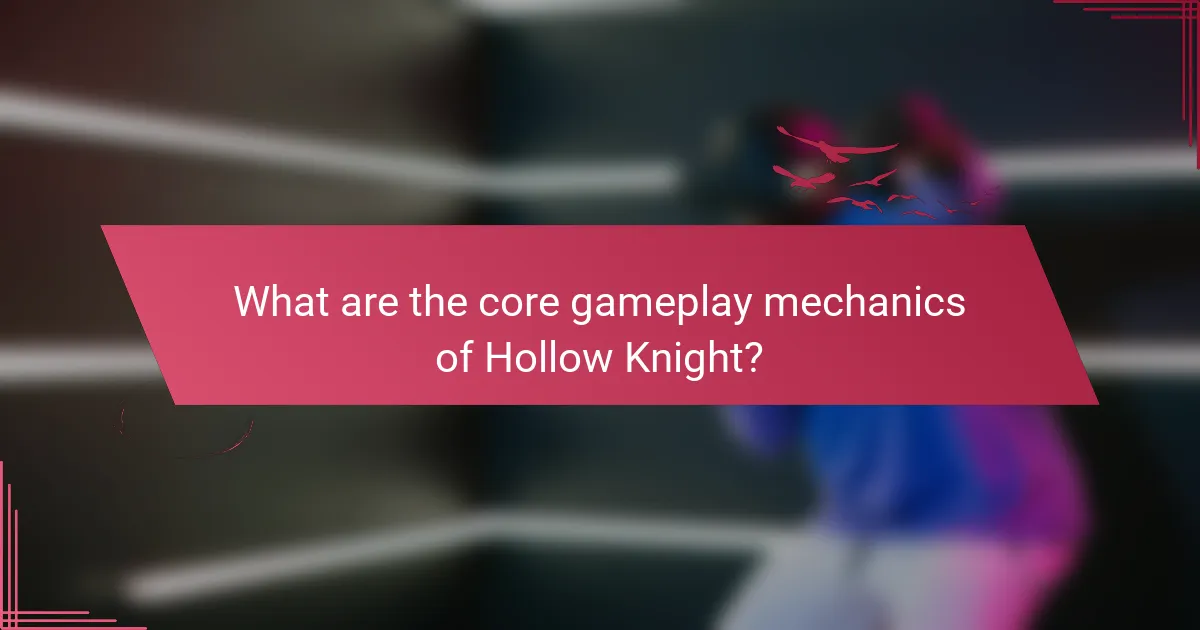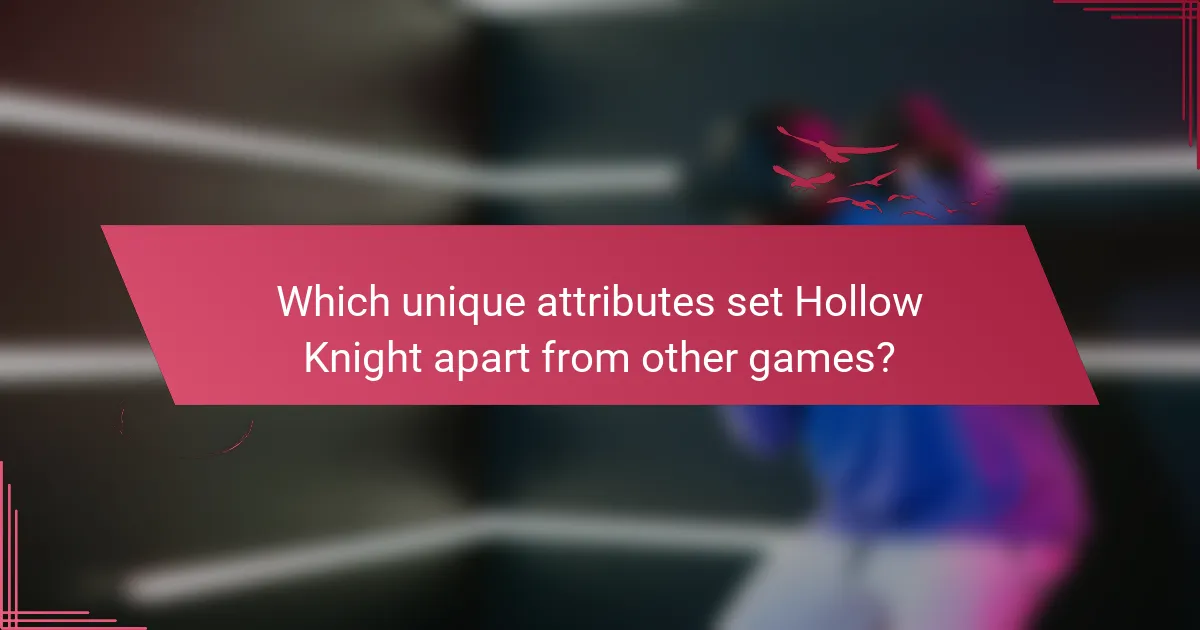Hollow Knight offers players a rich blend of exploration, combat, and narrative depth. The gameplay mechanics emphasize skillful timing and customization through a unique charm system. Its hand-drawn art style creates an immersive atmosphere, enhancing the storytelling experience. The narrative explores themes of isolation and identity within the beautifully crafted world of Hallownest.

What are the core gameplay mechanics of Hollow Knight?
Hollow Knight features intricate gameplay mechanics centered around exploration, combat, and progression. Players navigate a vast interconnected world, utilizing abilities to overcome obstacles and defeat enemies. Combat mechanics involve precise timing and skillful use of abilities, enhancing the challenge. The game incorporates a unique charm system, allowing customization of abilities to suit different playstyles. Exploration is rewarded with hidden secrets and lore, deepening the narrative experience. The art style complements gameplay, creating an immersive atmosphere that enhances the overall experience.
How does the combat system function?
The combat system in Hollow Knight is fluid and skill-based, emphasizing timing and precision. Players utilize a combination of melee attacks, spells, and defensive maneuvers to defeat enemies. The game features a diverse range of combat styles, allowing for unique player strategies. Key attributes include the ability to upgrade weapons and unlock new abilities, enhancing combat effectiveness. Unique enemies and bosses present varied challenges, requiring players to adapt their tactics. Overall, the combat system is designed to reward skillful play and exploration.
What role do abilities and upgrades play in gameplay?
Abilities and upgrades significantly enhance gameplay by providing players with new skills and improved performance. In “Hollow Knight,” players can acquire various abilities that unlock new areas and combat strategies. Upgrades, such as increased health or damage, allow for deeper exploration and more challenging encounters. The synergy between abilities and upgrades creates a dynamic experience, encouraging players to adapt their strategies. Unique abilities like the “Dash” and “Wall Jump” are essential for navigating the game’s intricate environments, while upgrades like “Charm Notches” offer customization options that cater to individual play styles.
How does exploration influence player experience?
Exploration significantly enhances player experience in Hollow Knight by fostering immersion and discovery. Players encounter hidden areas, unique enemies, and lore-rich environments that deepen engagement. The vast interconnected world encourages curiosity, rewarding exploration with upgrades and story elements. This design choice creates a sense of achievement and personal investment in the game.
What are the key challenges and enemy types?
Hollow Knight features several key challenges and enemy types that enhance gameplay. Players encounter various adversaries, including common foes, mini-bosses, and major bosses, each with unique attack patterns and abilities.
Common enemies, such as the Vengefly and the Zote, provide initial challenges and help players learn combat mechanics. Mini-bosses like the Great Knight test player skills further, while major bosses, including the Radiance, present significant hurdles requiring strategy and precision.
The game also introduces environmental challenges, such as platforming sections and hazards, adding layers to the gameplay experience. Mastery of combat and navigation is essential for overcoming these obstacles.

How does the art style of Hollow Knight enhance its narrative?
The art style of Hollow Knight enhances its narrative by creating a visually immersive world that reflects the game’s themes. The hand-drawn aesthetics evoke a sense of melancholy and beauty, drawing players into the desolate yet enchanting landscape of Hallownest. The use of color and shadow adds depth to the storytelling, with environments and character designs conveying emotions and histories without words. Each area features unique visual motifs that parallel the narrative arcs, enriching player engagement and emotional connection to the story. The art style serves as a silent storyteller, revealing lore and character backstories through environmental details and artistic choices.
What artistic influences shaped the visual design?
Hollow Knight’s visual design is shaped by influences from various art styles, particularly Gothic and Art Nouveau. The game’s dark, atmospheric environments reflect Gothic architecture, featuring intricate details and haunting imagery. Art Nouveau’s organic forms and flowing lines are evident in character designs and backgrounds, creating a unique aesthetic that enhances the game’s narrative depth. The combination of these styles contributes to the game’s immersive world, characterized by its rich textures and emotive landscapes.
How do color palettes and environments contribute to atmosphere?
Color palettes and environments significantly enhance the atmosphere in Hollow Knight by establishing mood and emotional resonance. The game utilizes a diverse range of colors to convey themes, such as the dark blues and greens of the Forgotten Crossroads, which evoke a sense of mystery and exploration. Each area features unique palettes that reflect its narrative context, deepening player immersion.
The art style complements these color choices, combining hand-drawn aesthetics with intricate details. This visual richness creates an engaging environment that invites players to explore and discover. For example, the vibrant hues of the City of Tears contrast sharply with the desaturated tones of the Resting Grounds, highlighting the emotional weight of each location.
Moreover, environmental design interacts with color to reinforce gameplay mechanics. Areas are visually distinct, guiding players through challenges and secrets. The atmospheric sound design further enhances this experience, creating a cohesive world where color and environment work in tandem to enrich the narrative depth.
In what ways does animation style affect player immersion?
Animation style significantly enhances player immersion by creating a cohesive visual narrative and emotional connection. In “Hollow Knight,” the hand-drawn art style evokes a sense of atmosphere, drawing players into its world. The fluid animations contribute to gameplay responsiveness, making actions feel impactful. Unique attributes, such as the game’s distinct character designs and environmental storytelling, further deepen immersion. Overall, the combination of artistic choices and animation fluidity establishes a rich, engaging experience that resonates with players.

What themes are explored in the narrative of Hollow Knight?
Hollow Knight explores themes of isolation, sacrifice, and the cyclical nature of life and death. The narrative delves into the struggle for identity and purpose amidst a decaying world. Characters embody these themes, reflecting the consequences of choices made in pursuit of power and understanding. Environmental storytelling enhances the emotional depth, inviting players to uncover the lore and interconnectedness of the game’s universe.
How does the lore unfold through gameplay?
The lore of Hollow Knight unfolds through gameplay by integrating environmental storytelling, character interactions, and item descriptions. Players discover the narrative gradually as they explore Hallownest, encountering remnants of the past and piecing together the history of the kingdom. Unique attributes like the interconnected world design enhance immersion, while root attributes such as challenging gameplay mechanics reinforce the narrative depth. As players progress, they unlock secrets and lore that deepen their understanding of the characters and events that shaped Hallownest. This blend of gameplay and storytelling creates a rich, engaging experience that invites exploration and interpretation.
What is the significance of character development?
Character development is crucial in “Hollow Knight” as it enhances emotional engagement and narrative depth. It allows players to connect with the protagonist, creating a more immersive experience. The gradual evolution of the character reflects personal growth, mirroring the challenges faced throughout the game. This development enriches the storytelling, making the journey through Hallownest more impactful and memorable.
How do player choices impact narrative outcomes?
Player choices significantly influence narrative outcomes in Hollow Knight. Decisions shape character interactions, alter story arcs, and determine the game’s conclusion. Each choice impacts the player’s journey, affecting the overall experience and emotional depth. For example, the choice to assist certain characters can unlock unique dialogue and quests, enhancing narrative richness. Additionally, the game’s multiple endings reflect these choices, encouraging exploration of different paths.

Which unique attributes set Hollow Knight apart from other games?
Hollow Knight stands out due to its intricate world design, fluid combat mechanics, and emotional storytelling. Its unique attribute is the seamless integration of exploration and combat, allowing players to engage deeply with the environment. The hand-drawn art style enhances immersion, creating a visually stunning experience. Additionally, the game’s narrative depth, conveyed through environmental storytelling and minimal dialogue, invites players to piece together its lore. These elements combine to create a distinctive gaming experience that resonates with players.
What innovative mechanics are exclusive to Hollow Knight?
Hollow Knight features innovative mechanics like the unique charm system and fluid movement abilities. The charm system allows players to customize their skills and playstyle, enhancing gameplay depth. Fluid movement mechanics, including wall jumping and dashing, provide a dynamic platforming experience. Additionally, the game’s interconnected world design encourages exploration and discovery, making navigation a core mechanic. These elements contribute to the game’s distinctive identity within the Metroidvania genre.
How does the game balance difficulty and accessibility?
Hollow Knight balances difficulty and accessibility through its adaptive gameplay mechanics. The game offers a challenging experience with precise controls and intricate enemy patterns, catering to skilled players. However, it provides accessibility through checkpoints and the ability to customize abilities, allowing players to adjust their approach. Additionally, the art style creates an immersive environment that encourages exploration without overwhelming players. This dual approach enhances engagement while accommodating a range of skill levels.

What rare attributes enhance the player experience in Hollow Knight?
Rare attributes that enhance the player experience in Hollow Knight include unique enemy designs, intricate lore hidden in the environment, and dynamic boss encounters. These elements create a rich, immersive atmosphere that encourages exploration and discovery. The game’s hand-drawn art style adds to its distinctiveness, while the fluid combat mechanics provide a satisfying gameplay experience. Additionally, the emotional depth of the narrative resonates with players, further enhancing engagement.
How do hidden areas and secrets contribute to replayability?
Hidden areas and secrets significantly enhance replayability in Hollow Knight by encouraging exploration and discovery. Players are motivated to revisit locations to uncover hidden content, which adds layers to gameplay. This mechanic fosters a sense of achievement and curiosity, as players often find new abilities, lore, or challenges. Unique secrets may lead to rare items or upgrades, deepening the overall experience. The interconnected world design allows players to approach the game differently in subsequent playthroughs, ensuring varied gameplay each time.
What role do community-driven elements play in the game’s longevity?
Community-driven elements significantly enhance the longevity of Hollow Knight by fostering player engagement and collaboration. Players share strategies, tips, and fan art, creating a vibrant ecosystem around the game. This interaction cultivates a sense of belonging, encouraging players to return and explore new content. Additionally, community feedback often influences updates and expansions, ensuring the game evolves with its audience. The unique attribute of community involvement not only sustains interest but also enriches the overall narrative depth and gameplay experience.

What strategies can players use to maximize enjoyment of Hollow Knight?
Players can maximize enjoyment of Hollow Knight by exploring thoroughly, mastering combat mechanics, and engaging with the narrative. Embrace the intricate world design to uncover hidden areas and secrets. Focus on refining skills, as the game’s challenging enemies require precise timing and strategy. Immerse yourself in the rich lore and character interactions to deepen the overall experience.
What are the best practices for mastering combat techniques?
To master combat techniques in Hollow Knight, focus on practice, timing, and adaptability. Engage in consistent gameplay to refine your skills.
1. Learn enemy patterns: Observe and memorize attack sequences to anticipate movements.
2. Utilize the right charms: Select charms that enhance your combat style and provide advantages.
3. Practice dodging: Master the dash and jump mechanics to evade attacks effectively.
4. Experiment with different weapons: Find the weapon that suits your playstyle while maximizing damage output.
5. Analyze your performance: Review encounters to identify mistakes and areas for improvement.
How can players effectively navigate the game world?
Players can effectively navigate the game world of Hollow Knight by mastering its movement mechanics and utilizing map features. Understanding the abilities such as dashing and wall climbing enhances exploration. Players should frequently check the map for new areas and use markers to track progress. Engaging with NPCs provides valuable lore and quest information that aids navigation. Additionally, learning enemy patterns is crucial for survival and unlocking new paths.
What common mistakes should players avoid while playing?
Players should avoid common mistakes like neglecting exploration, failing to learn enemy patterns, and mismanaging resources. Understanding the game’s mechanics enhances overall success.
Neglecting exploration can lead to missing valuable upgrades and hidden areas. Players should thoroughly investigate each environment to uncover secrets that improve abilities.
Failing to learn enemy patterns results in unnecessary deaths. Observing attack sequences allows players to anticipate and counter effectively, improving combat efficiency.
Mismanaging resources, such as health and currency, can hinder progress. Players should prioritize upgrades and healing items to maintain momentum during challenging encounters.


